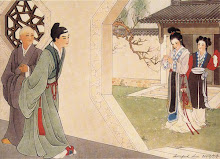20 May 2019
Baikonur: space-age romanticism and færie realism
I recently watched the 2011 German-Kazakhstani romantic comedy Baikonur directed by Veit Helmer and starring Alexander Asochakov, Marie de Villepin and Sitora Farmonova. Outlandish and charming, its love story sometimes seems to take a back seat to broader themes, not least of which are the (post-)Soviet enthusiasm for space, the more prosaic impacts of the space programme on local life, and more generally on the tension in Kazakh life between tradition and modernity. Caught thematically between Jules Verne and the Brothers Grimm, ‘Eastern’ and ‘Western’ themes blend together in odd ways, as does the strange relationship between Kazakh semi-nomadic life and literal rocket science. Baikonur seems to delight in, and explore to a much better effect than I did, the odd confluence between folklore and space exploration. (I still think the folkloric choice of name for the Chinese rover, its landing on Tolkien’s birthday, and the actual attempt at lunar agriculture, are all more than a little suggestive that way!) It also makes a point of turning inside-out our expectations of sæcular space and time. Space is enchanted; even the old Soviet machinery of the ISS seems to operate by the logic of mediæval romances. And yet the characters who are most attuned to ‘færie’ are also the ones most drawn back to earth, to the realities of the situation of ‘the people here’.
The cinematography is excellent; it must be said that Helmer seems to have a taste for a human-level view of big things and big events. Helmer is judicious and effective, with a subtle wink and nod to the audience, in his use of archival footage of old Baikonur launches: he knows exactly the kind of space-age nostalgia and Star Trekky feelings of exploration he is evoking. In fact, the opening sequence sees Nazira sketching rocket launches in the sand, while archival footage of old Baikonur launches transitions in from the background.
We get treated to a lot of ground-level shots of the eponymous Cosmodrome and the Kazakh steppe – the grand stage for the very relatable and very poignant human drama among the protagonists. Speaking of which, the acting is also quite good. Asochakov absolutely nails his performance as Iskander ‘Gagarin’ Orynbekuly – a crafty but good-hearted Kazakh whiz-kid who aids his village by maintaining the radio equipment which helps them scavenge and trade in scrap metal from jettisoned modules of rocket launches at the nearby Cosmodrome. (The Kazakhs justify this with the principle that ‘whatever drops from the sky is a gift from God’.) Disarmingly earnest and sweet, Iskander’s dreams of becoming a cosmonaut himself are played arrow-straight, without the slightest hint of irony. His fellow nomad Nazira, played by Farmonova, clearly has a liking for Gagarin but shows it mostly by teasing him or by giving him folkloric advice (all of which seems to come true at one point or another in the film). But Gagarin has eyes only for the French tourist-cosmonaut Julie Mahé – played by Marie de Villepin – whom he watches prior to her launch on the television, and then later discovers comatose on the steppe after her capsule lands back on Earth.
Warning: as usual, there are SPOILERS in the discussion of the plot below.
In the broad strokes: we get introduced to the two sides of this love triangle early on. On the one side, we get scenes of Julie Mahé as she is preparing for her launch – long and loving shots of rockets being hauled on Soviet-era trucks to the launch site; a Russian Orthodox priest blessing the rocket and astronauts with aspergillum and holy water; the countdown and liftoff; Julie entranced by the outline of the earth as seen from space; the docking at the International Space Station. Mahé’s ecstasy is mirrored precisely in Gagarin’s love of everything rocketry- and space-related – he even keeps in touch with a Kazakh technician in the Cosmodrome who apparently comes from the same aul. Gagarin and Julie share the same rapturous gazes skyward, the same dreams of spaceflight. But Gagarin, when he turns on his old television set and sees Julie’s face there as she’s on her way up, finds his space-age romanticism transmuting itself into puppy love.
All the while, Gagarin’s perpetually-dishevelled childhood friend Nazira – like him, an orphan, due to the dangerous (and, we later learn, poisonous) nature of their aul’s scavenging work – likes to spend her time either yelling at him or insulting him. But it’s more than clear she harbours deeper feelings for him, and doesn’t see him merely as a geeky younger brother. (Nazira’s definitely a Type A tsun that way.) We see her offering him sage advice and camel dung for engineering purposes; and we get the clear sense that she’s something of a ‘diamond in the rough’, but Gagarin’s a bit too intent on his scavenging work (and daydreaming about space and Julie) to notice her. By the way – the wide-angle shots of the aul are terrific: traditional yurts decked out in bits and pieces of scrap metal from the Cosmodrome.
Julie’s ISS tour comes to a close and she is sent home – but a calculating error causes her module to overheat on reentry and crash into the Kazakh steppe ‘under the radar’. Gagarin finds her crashed pod and Julie herself inside, comatose – he carries her back to his yurt, makes her comfortable, but finds he can’t wake her up. Nazira suggests that he wake her up with a kiss, like in Sleeping Beauty, and then teases him about being a bad kisser when he can’t. (She then promptly demonstrates how to kiss properly – on him.) Gagarin eventually succeeds in waking Julie up – but she has amnesia and can’t remember anything about herself.
Due to several miscommunications on the part of Gagarin (who tries to get her the bathtub she asks for), Julie becomes convinced that she’s Gagarin’s köketai – his fiancée. Nazira is not too happy about this, and she throws some great shade on Julie and Gagarin as she remarks: ‘Must be nice to just forget everything.’ She later tells Gagarin: ‘If you touch her, you will lose her.’ The two bickering village elders also try to get Gagarin’s köketai off him with cash, each trying to outbid the other. When Gagarin’s grandfather informs the Cosmodrome that Julie has been found, Gagarin takes her out of the aul and into a cave, where Julie starts eagerly making love to him. As they climax, Julie suddenly – and awkwardly – regains her memory, and promptly storms out of the cave, furious with Gagarin for having deceived her. The hapless but entirely earnest Gagarin meekly offers to return her to the Cosmodrome… but later lands himself a job at the Cosmodrome by leveraging his discovery of Julie to the embarrassed and mortified director of spaceflight, who doesn’t want it leaked to the press that Baikonur lost one of its cosmonauts.
At the Cosmodrome, Gagarin makes every effort to get back in touch with Julie, but his efforts are frustrated. He even enters the cosmonaut programme and is promptly hazed by the Cosmodrome technicians by being put in the high-G centrifuge. (He acquits himself well at eight G’s – the gobsmacked technicians remark that he’s ‘just like the real Gagarin’.) He eventually manages to meet up with Julie, who is working on a solar panel in her spacesuit – for a moment, we are fooled into thinking that he went up to space to meet her, but, in a nice cinematographic touch, we learn they’re in the training tank when bubbles start rising around their helmets. Julie, who is eager to get up to the space station again, repeatedly puts him off – to the point where Gagarin uses camel dung from his village to sabotage the space launch so he can talk to Julie one last time.
When he finally does, Julie admits she’s impressed by Gagarin and that his köketai really did love him, but tells him point-blank that she’s not the person he thinks she is, and that her heart is already given to the stars – which appears to be a definitive moment at which Gagarin realises that he does, in fact, care about ‘the people down here’ more than he does about spaceflight.
This transition, if it had been handled cursorily or without a certain degree of foreshadowing, would have come off as a bit cheap. But Gagarin clearly does care about his aul, even when he’s bickering with Nazira or trying to skive off collecting space scrap. At the Cosmodrome, Nazira visits on horseback to tell him to either come back or teach her how to use the ham radio, so the old folks at home won’t starve – which Gagarin reluctantly does. (Nazira doesn’t succeed in using the radio, and to cool her frustration takes a bath in Julie’s bathtub instead.) Gagarin is clearly affected when he learns the village elders have injured each other in a fight over scrap, and he is shaken when he learns that the scrap metal they’d been harvesting is carcinogenic. When Gagarin’s friend the Kazakh technician tells him not to worry about the aul – he’s got a great cosmonaut career ahead of him – that’s when he decides to walk away from the Cosmodrome. Significantly, he dons a takiya and a traditional Kazakh jacket as he does so – and immediately goes out and buys two lambs for breeding. (This is where we get to see the cameo by Nursultan Nazarbaev’s granddaughter, as the incredibly-cute but hard bargain-driving shepherd girl.) He comes home to his aul and is greeted at once by a glowing, freshly-bathed Nazira in a clean koilek, who comes and sits with him as they watch Julie’s rocket lift off from the Cosmodrome.
End spoilers.
This film is, for the most part, a sweet and slightly sad tale of first loves – but it’s also in itself something of a mournful love song for a bygone age of space-bound optimism, enthusiasm, big dreams for a humanity united by common technological endeavor; and, at the end of the day, a reaffirmation of the realism of ancestral wisdom. Baikonur with all of its now-incredibly dated technology is shown pretty straight – big-box electronics with knobs and dials and incandescent indicator lights under bits of coloured plastic; exposed tubes and wires and hardware-store engineering – and that is sometimes (as in the part where Gagarin sabotages one of the valves with camel dung) played for laughs. But Helmer wants us to look at Baikonur through Gagarin’s and Julie’s eyes: to look heavenward and see and understand the enchantment of spaceflight as it took people during the space race. Helmer wants us to touch our hearts with the grand, Vernean Romanticism which inspired not just the Space Race, but also Star Trek and the American and Soviet science-fictional traditions.
By way of contrast, the Grimmish, Chestertonian-Tolkienian færie-tale logic embodied by Nazira’s proverbial wisdom actually manages to bring Gagarin (and us) back down to earth (or, dare I say, there and back again?), to get us to look level at ‘the people back here’. Nazira is the true believer in the ‘doctrine of conditional joy’; the one who keeps reminding us of the hidden costs of reaching for the stars. She’s the one who first suggests that: the metal is poisonous; that orphans should stick together; that the sleeping princess can be awoken with a kiss; that touching her will mean losing her; that to fly up into space is to trespass on the realm of the ancestors. Nazira’s heartfelt kiss might have had something of a delayed effect, but that was what woke Gagarin up from his space-bound dreams, and turned him back toward the aul, the nomadic life, the traditional œconomy. It’s the færie logic and the traditional wisdom that helps Gagarin to grow and mature as a character.
Still, Helmer is a skilled enough director that he doesn’t make his point in a ham-fisted way, or try to answer the dilemmas for us. The final frame manages to showcase the real draw on both sides of that – the fields where the lambs will graze being brilliantly lit up by a blastoff. Yet the question remains very much open whether the two of those can indeed coexist in the long run. I’m somewhat over-intellectualising it here, though. Baikonur is what it is – a sweet, quirky and very post-Soviet romantic comedy, and one which I would highly recommend to the age-appropriate audience.
Labels:
Alash Orda,
books,
folklore,
Holmgård and Beyond,
just for fun,
La Gaule,
movies,
science fiction,
technology,
Teutonia,
Toryism
Subscribe to:
Post Comments (Atom)














No comments:
Post a Comment